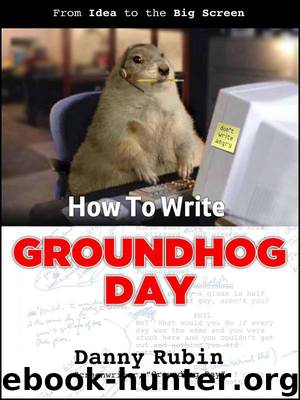How To Write Groundhog Day by Danny Rubin

Author:Danny Rubin
Language: eng
Format: mobi
Publisher: Triad Publishing Company
Published: 2012-01-26T16:00:00+00:00
Developing Groundhog Day
I wrote this original draft as a “spec” script, which stands for “speculative” or “on my own time.” Nobody paid me to do it.
Harold had read the script and asked Columbia Pictures, the studio with whom he had a relationship, to option this screenplay from me for him to produce and direct.
The studio said yes and I met Harold.
He couldn’t have been nicer or more complimentary about the screenplay, which is all very flattering. I of course knew his work—from SCTV to Animal House, Caddyshack, and Ghostbusters. I was very happy to be in that room.
I was pleased—yet wary—that Harold knew how to write a screenplay. His being a writer was both comforting and threatening. I felt protective of the work and did not want to be railroaded by somebody else’s vision. But Harold knew the craft in a way I didn’t, and no matter how badly I messed up, I felt at least there was somebody who could fix it.
I had already met Harold’s producing partner on this project, Trevor Albert, who actually had been the first to pick this screenplay off the pile and make sure Harold read it. I guess he’s the one you’ve got to thank for all of this coming together.
My first draft had everyone’s excitement, but it was not really structured anything like a Hollywood movie, and certainly not like a genre comedy. Everybody agreed there would need to be changes.
I met with Harold and his associates several times before I disappeared for a couple of months to write a revised draft.
Those meetings were fun and fascinating. We went through the script and discussed point by point what was working and what wasn’t, but we also had free-ranging discussions about Zen, Bruno Bettelheim, Joseph Campbell, and the “Superman problem.”
For me the most helpful, clear, and useful notes related to Harold’s focus on the love story. His suggestions about Rita’s relationship to Phil’s story and the timing and importance of their ins and outs were all pretty close to what came about in the final film.
The meetings were also frustrating and bewildering, and reviewing my early notes has reminded me how much discussion revolved around solving the problem of causality: What was the source of Phil’s repetition? This was something I did not even want to consider, but clearly there was an assumption that the studio at least might want us to explain the repetition, and I was determined to be as helpful as I could.
Still I returned from every meeting trying to figure out not just which suggestions to follow but, more profoundly, how much to be an accomplice to implementing ideas I didn’t like or understand.
I submitted my new draft of the script on February 2, 1991. Harold then took that draft and wrote his own revision.
I had in fact been hired to write two revisions of my original script—at the time that was fairly standard procedure. A writer coming in with an original script got the first two shots at changing it.
Download
This site does not store any files on its server. We only index and link to content provided by other sites. Please contact the content providers to delete copyright contents if any and email us, we'll remove relevant links or contents immediately.
Shoot Sexy by Ryan Armbrust(17637)
Portrait Mastery in Black & White: Learn the Signature Style of a Legendary Photographer by Tim Kelly(16933)
Adobe Camera Raw For Digital Photographers Only by Rob Sheppard(16882)
Photographically Speaking: A Deeper Look at Creating Stronger Images (Eva Spring's Library) by David duChemin(16601)
Bombshells: Glamour Girls of a Lifetime by Sullivan Steve(13953)
Art Nude Photography Explained: How to Photograph and Understand Great Art Nude Images by Simon Walden(12954)
Perfect Rhythm by Jae(5306)
Pillow Thoughts by Courtney Peppernell(4190)
The Book of Joy by Dalai Lama(3882)
Good by S. Walden(3468)
The Pixar Touch by David A. Price(3345)
A Dictionary of Sociology by Unknown(2998)
Fantastic Beasts: The Crimes of Grindelwald by J. K. Rowling(2977)
Humans of New York by Brandon Stanton(2814)
Stacked Decks by The Rotenberg Collection(2796)
Read This If You Want to Take Great Photographs by Carroll Henry(2653)
On Photography by Susan Sontag(2563)
Insomniac City by Bill Hayes(2480)
Photographic Guide to the Birds of Indonesia by Strange Morten;(2476)
